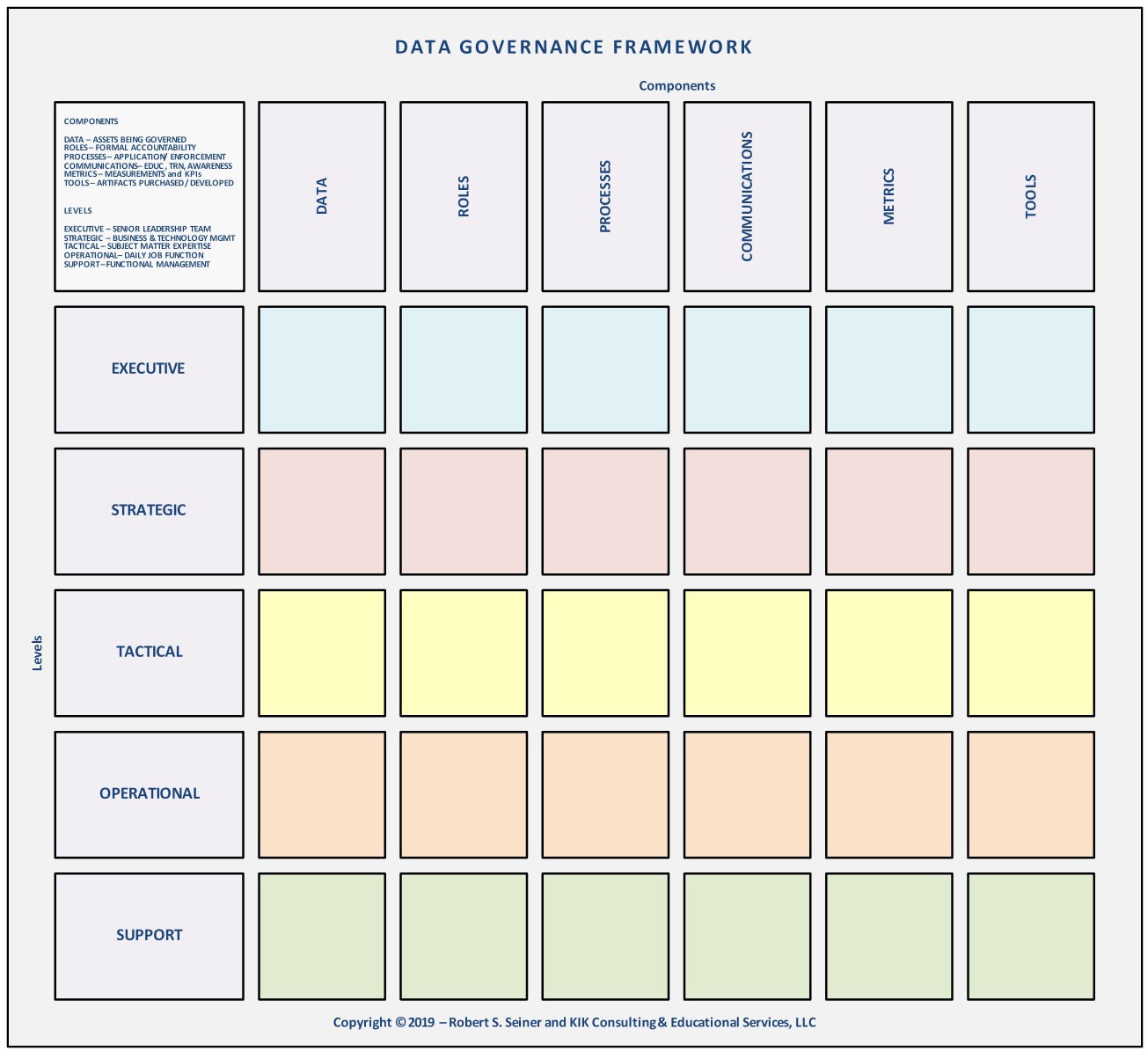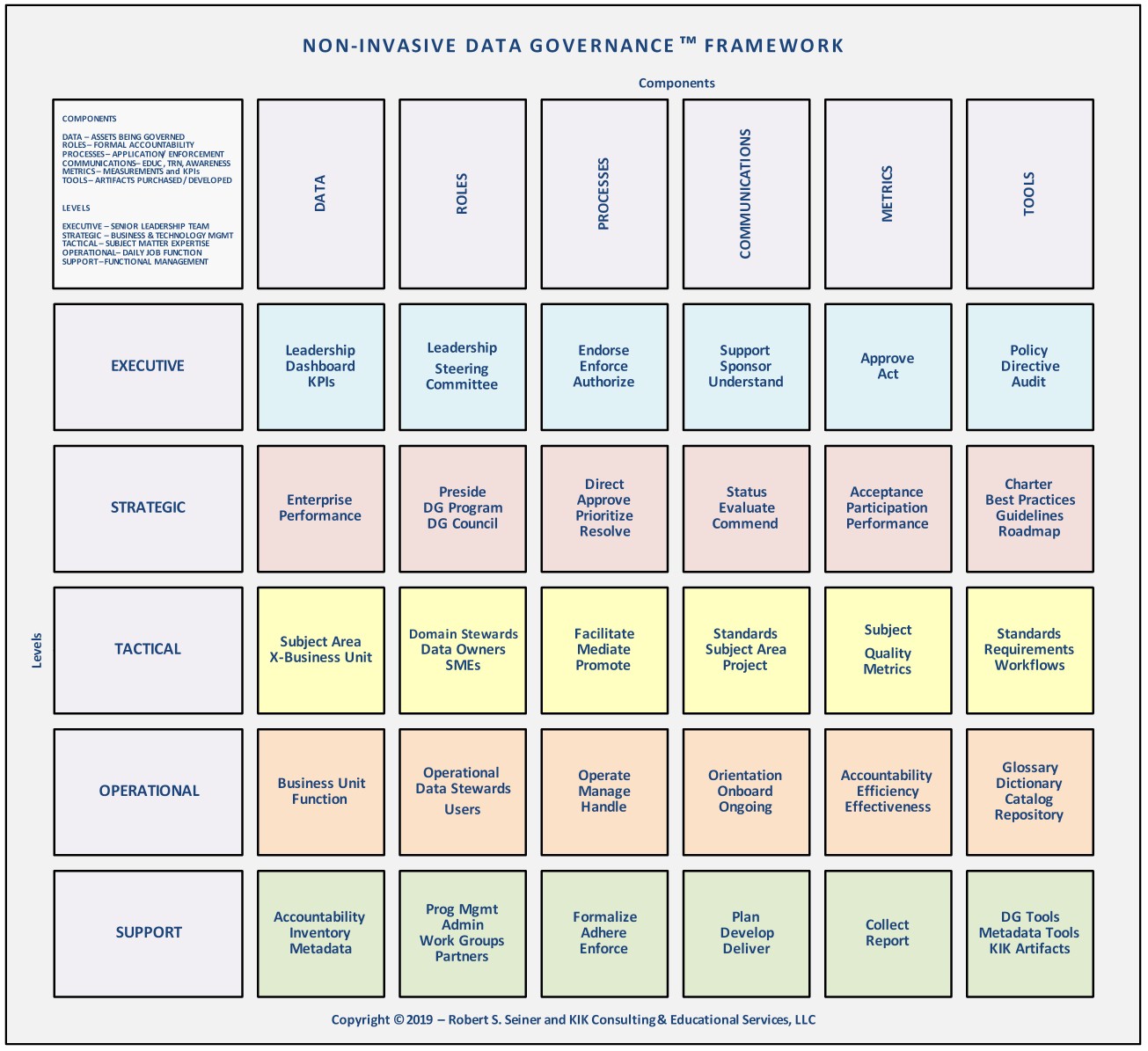 The following paper is the first of a three-part series that describes the Non-Invasive Data Governance Framework. The framework was developed and is implemented by Robert S. Seiner of KIK Consulting & Educational Services (KIKconsulting.com) and The Data Administration Newsletter (TDAN.com). Seiner is an experienced data governance specialist and the developer and practitioner of the Non-Invasive Data Governance™ approach. Seiner is also the author of the book (10/2014) named after the NIDG approach.
The following paper is the first of a three-part series that describes the Non-Invasive Data Governance Framework. The framework was developed and is implemented by Robert S. Seiner of KIK Consulting & Educational Services (KIKconsulting.com) and The Data Administration Newsletter (TDAN.com). Seiner is an experienced data governance specialist and the developer and practitioner of the Non-Invasive Data Governance™ approach. Seiner is also the author of the book (10/2014) named after the NIDG approach.
The first part of the series focuses on the structure of the framework, basically a two dimensional matrix that cross-references the core components of a successful Data Governance program with the levels (or perspectives) of the organization from the Executive to the Support levels of the organization.
The second part of the series will share a description and the specifics of what makes up each of the core components and each of the levels of the framework, while the third part of the series will address the details of where the components are viewed from each of the levels.
In this series, the focal discipline is named “Data Governance” —because that is the term presently used by industry leading associations as the name of the data management practice area— rather than “Information Governance” which is often considers the governance of all information assets including structured data, unstructured data, records and information, etc. This framework could just as easily be called the Non-Invasive Information Governance Framework. The levels and components are the same.
The framework is broken into the primary components of delivering a successful program and the levels of the organization to which the components of data governance must be applied. The detail of what is required to deliver a successful program occur where each level (row) is addressed for each component (column) in the framework.
The Levels of the framework are mostly people and authority-based. Many organizations use similar definitions when it comes to defining how they operate. The levels defined in this framework should look familiar to you if you are acquainted with the Non-Invasive Data Governance™ Operating Model of Roles & Responsibilities described in my book, presentations, and webinars.
The Framework Levels are defined as:
- Executive – Senior Leadership Team
- Strategic – Business & Technology Management
- Tactical – Subject Matter Expertise
- Operational – Daily Job Function
- Support – Functional Management
The Components of the framework are the core moving parts of governance in action for most organizations. The components focus on clear roles and responsibilities including how to resolve issues, engage, and communicate with each of the defined levels. The second to last component focuses on the definition of success and value for the data governance program, and the association of how and who to measure for these metrics.
The Framework Components are defined as:
- Data – Assets Being Governed
- Roles – Formal Accountability
- Processes – Application / Enforcement
- Communications – Education, Training and Awareness
- Metrics – Measurements and Key Performance Indicators (KPIs)
- Tools – Artifacts Purchased & Developed
The Empty Framework
A diagram of an empty Data Governance Framework is shown below. The matrix focuses on six core components of Data Governance described at each of five core levels of the organization. This version of the framework is left blank to make the point that, what makes the framework non-invasive in the first place, is how the cross-section of each component and level is planned, defined, developed and deployed across the organization.
The message being delivered by the empty framework is that this diagram does not demonstrate meaning to the organization unless each of the squares are filled in with nouns and verbs representing the path that will be taken to plan, define, develop, and deploy each of the core components at each of the respective levels.
The Completed Framework
A completed diagram of the Non-Invasive Data Governance Framework is shown below. The matrix cross-references each of the six core components of Data Governance with each of the five core levels of the organization. This version of the framework is completed with nouns and verbs to guide how each component and level is planned, defined, developed, and deployed across the organization.
The message being delivered by the completed framework is that this diagram demonstrates meaning to the organization and jumping-on points for discussion and planning for the definition, development, and deployment of each of the core components at each of the respective levels.
In the next part of the series I will provide a detailed description of each of the core components and levels or perspectives including a description of how the components and levels are often defined in regard to following the Non-Invasive Data Governance approach. I hope you will return to read the next two sections. As always, I am interested in people’s reaction to the framework and how it is being used to implement successful Data Governance programs.


